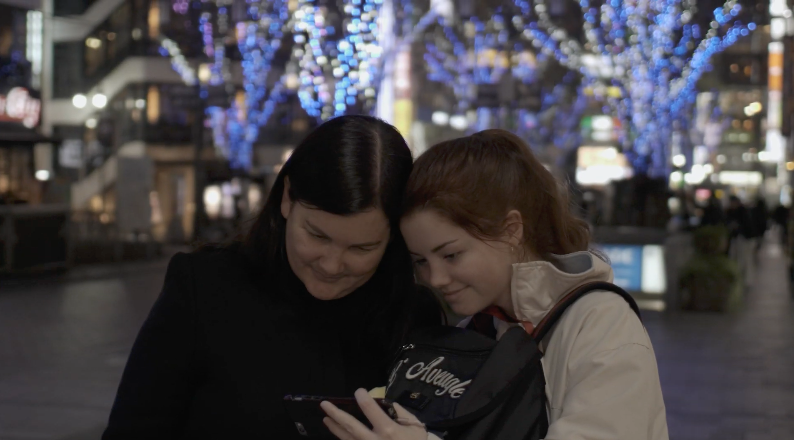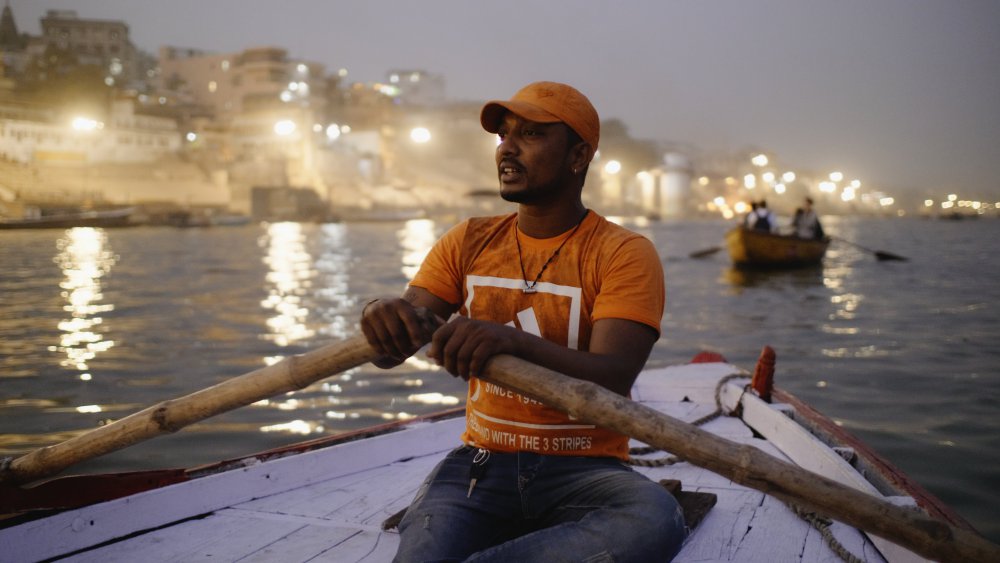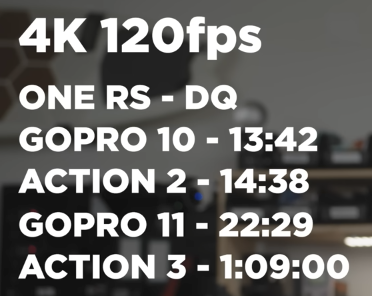-
Posts
7,835 -
Joined
-
Last visited
Content Type
Profiles
Forums
Articles
Everything posted by kye
-
I think there's two competing goals in effect with this stuff - having a technically good image and having an emotionally effective image. I say competing because one wants technical perfection and the other wants aesthetically pleasing imperfections / distortions like motion blur, image texture in the form of noise, etc. The nuance that I think doesn't get explored enough is that an image doesn't get more emotional the worse the technical aspects are, and I think people often think that's what's going on, but it's that there are very specific imperfections that are aesthetically desirable. The right quantity and type of motion, the right type and quantity of noise, the right type and quantity of overall resolution in the image. I've found that often images with motion blur, out-of-focus elements (foreground and/or background), and noise often benefit from a very small-radius blur applied to the image. The purpose of this blur is to make the in-focus parts of the image less sharp, which I think aides in the overall feel. Of course, applying the blur will also do NR, so you might want to add grain back over the top of that blur too. Your approach sounds, well, sound. It borrows lots of elements from street photography, and I know that in my shooting (mostly family holidays and travel) I have learned a great deal from street photography as its main focus is in getting optimal results with often no control of the situation at all. Quite appropriate for both family holidays and informal event photography alike! In terms of dealing with the lowest light, the tradeoff is real between ISO noise, lens aperture (wider = lower ISO but softer image, stopping down = higher ISO but sharper image), and exposure time (which is dependent on subject motion). I did tests many years ago and found that it was really camera-dependent, if you're trying to eek out that last bit of performance. Obviously you can pre-focus and find a pool of good light and a good composition, but even with that I think there's an argument to be made for stopping down as it means you're going to have more chance of getting the subject in focus. I'm not sure if you've seen these images I've posted before, but I've done quite a bit of very low light video with the GH5 and Voigtlander 0.95 lenses. This was on a boat out on the water, the only lighting was from the lights on shore, which are a loooong way from the boat: Those shots are completely mis-representative of the conditions - in real life both of them were in conditions where it was dark enough that if you were alone you'd start to be concerned about your safety because you wouldn't see clearly enough to see trouble coming and if something happened other people wouldn't be able to clearly see what was happening. I've also captured lots of shots in situations where the shot was being equally lit by the persons phone (held maybe 15" from their face) as it was by the surrounding light. I have great night vision (I can ride mountain bikes off-road without lights under a full moon) and the GH5 and f0.95 lenses can see better than I can in low-light.
-
The sensor might be smaller, and the screen will be smaller too, but all the video processing / compression and saving to SD are the same, so I don't think the sensor size is the dominant factor. If an action camera is half the size of an APSC camera then it's only got a quarter of the surface area. Your RX100 is a great counter-example - tiny sensor size (same as some of those action cameras) and overheated anyway. Seems like it's a Sony thing with them just cramming as much stuff in and saying "you didn't buy a Venice, just be thankful we sold you a camera at all".
-
Cool shots! I saw some had the longer exposure time, which suited the situation well as it showed the motion. I think motion blur in photos is highly under-rated as it removes the movement of the moment, which often is a critical aspect of the situation - a 1/5000s shutter freezes the dancing and the longer you look at the image the more the people look like mannequins who are motionless rather than there being life in the shot.
-
Yeah, that sounds like a difficult environment, and F1.4 is only a stop better than your current lenses which isn't that much in the grand scheme of things. You can also slow the shutter down to 270 or even 360 degrees, which will make the footage more surreal, but that's how weddings are anyway, so it might be a nice effect, especially on wide shots where the motion-blur wouldn't be so large compared to the size of the frame. @MrSMW may have some additional advice, but I've heard of people resorting to adding their own lighting in such situations. A couple of strategically placed Lume Cube style lights might make up the difference perhaps? IIRC I've heard wedding videographers say that if you use small lights with a hard light then people seem to ignore them much more than bigger lights or light panels, plus those ones are battery powered so could literally just be placed somewhere up high. They wouldn't last long, but you probably only need to record for 5 minutes to get a few usable shots.
-
Not all small black cameras have these issues. Here's a test of a bunch of small black cameras: He did the tests in a room at 75F/23.9C and he cooled them down to 80F/26.7C before starting the test. Results: Looking at some of these results, I'm not sure your theory stands up. Comparing them to the Sony, these are obviously smaller sensors, but heat management is about power consumption vs surface area, and these all have MUCH smaller surface areas than a MILC like the Sony.
-
If it's an option for you, there are a bunch of really fast manual primes for MFT available for ridiculously small prices now, especially from TTartisans: https://ttartisan.myshopify.com/collections/aps-c-lenses?sort_by=created-descending&filter.v.price.gte=&filter.v.price.lte=&filter.v.option.mount=M43 I've got the 17mm F1.4 and the 50mm F1.2 and they're basically the same level of optical performance as the (much more expensive) Voigtlander F0.95 MFT primes. The F1.4 lenses are two stops faster than a F2.8 lens and at the native ISO800 on the BM cameras is almost as much low-light advantage as having a second native ISO (the second ISO on dual-native ISO cameras are often only 3 stops above the base one).
-
I remember one of the first experiments we did in school teaching us about doing experiments. We got two tin cans, put a hole in each of them, put a thermometer in each to read the internal temperature, and then wrapped one in black paper and one in white paper. Then we put them in the sun and took temperature readings over something like 30 minutes. The black container internal temp shot up quickly, and it felt hot to the touch after only a few minutes, but then the temperature started to plateau. The white one started much more gradually, but slowly and surely kept rising. Every minute we took readings and drew graphs of both of them. We were able to compare the two graphs and IIRC the white one was following the same curve, it was just slower. By the end of the experiment the white one had almost caught up to the black one. The colour delays the rise in temp, it doesn't eliminate it. Maybe that is enough difference to get the shot rather than not getting it, but it's not a permanent solution.
-
No specific advice from me, but what you've said above sounds reasonable. I'd just say that if you can do any testing beforehand then that's something that always pays dividends. If you need any help in grading things afterwards then just ask, happy to take a look and help if I can. I'd imagine the client would expect the video to look similar to the photos? If so, I'd suggest trying each mode in your tests beforehand and see what the default profiles look like under those conditions so you can choose the optimal one.
-
-
Wow.. I thought the overheating issues were likely when the camera was in the sun (which definitely heats black objects) but that was in the shade..... Yeah, lots of people are going to buy this camera and then find themselves with a new appreciation of using their phone.
-
In theory, yes, these things are all true, but not for this camera. Here's the video posted earlier by @SRV1981... check out the outside testing. In case you don't want to watch a couple of minutes of video, here's the results: Tested in North Carolina in mid-morning 80F and humid, in direct sun Tested from cold in AC all night Tested in 4K XAVCS, auto temp set to high, screen open Tested at 24p Overheated in 22 minutes Let me summarise: camera is not reliable. Will it work for some people in some conditions? Sure. Will it work for you? No way to tell. There's no way I'd buy a camera like this, because you would have to know you can't record with it in the sun (even at indoor temps!), or in a hot building, or at 60p, etc etc
-
IKR... and for those long voiceovers that you get from interviews, well, that's AI isn't it. Maybe that's the end-game... Sony cameras: Recording times ready for AI™
-
Meanwhile, I'm 14 hours into the recordings of a 20hr course done over Zoom to people all over the world on combining blending modes and alternative colour spaces to get better colour grading in Resolve. Yeah, things have moved on just a bit! Not much support for Jacobs Ladder when cutting S16 🙂
-
One saying I keep reminding myself and other people of is "Can doesn't mean should, and should doesn't mean will". Just because you can do something doesn't mean you should... otherwise we'd all have to murder everyone. Or, if you decide that's a ridiculous example (and you might be right) then I guess you'd better stop reading and go pick fruit somewhere for minimum wage, because if you don't then you're "leaving money on the table".
-
The thing I find funniest is that people seem to think shooting long clips = watching long clips. It's like they've never heard of editing.
-
The monitor I use on the BMMCC has custom buttons which are super useful so I'd suggest getting familiar with those. Considering your eyesight is the main challenge, a zoom-in function might be a good one to have quickly accessible. Of course, the ergonomics of it in the rig and how to access the controls etc are another matter entirely.
-
A saying I hear a lot is "a rising tide lifts all boats". The opposite of that is when the tide goes out and the boats that don't float well hit the rocks and sink.
-
Perfect for the Scandinavian market!
-
Just to pile on.... Source: https://goodereader.com/blog/bookselling/reading-books-is-on-the-decline Those stats are from 2018. I don't think the trend would have reversed in the meantime.
-
There's a name for this already, which I've heard on occasion in videos. IIRC it is "Hollywood" - ie, "we grabbed a few runners and just Hollywooded the lights because we had to shoot quickly as the sun set".
-
Any industry that seems glamorous will have newcomers and amateurs undercutting the pros and starting a race to the bottom for all but the top performers who have managed to build a reputation. Meanwhile, in industries that don't seem glamorous, there are skills shortages and prices are going up (or quality goes down)...
-
True, but he used pretty good clubs too. No "I use the worst clubs I can get because it's all about skill not equipment" going on in the real world....
-
If you're doing something in person and have a sunny disposition (or a personality that others are drawn to) then yeah, very difficult for AI to replicate that, at least in the short or medium term. If you're separated from your customers and the clients only experience of your work is the deliverables then that's a much tougher proposition. We can't change our stripes to suit the current whims of capitalism and technology, but we have the ability to choose how respond to the world around us, even if we can't decide how it should be, and that might be enough for quite a few people. In my corporate day job there are AIs that can do the practical stuff way better than I can, but one of the primary reasons they're "better" is that they ignore the human factors and make rational decisions. As a human, I know that the preferences and personalities and politics and culture and history and various X-factors that are in play often overshadow the "rational" answer, and even beyond that, I know when they do and when they don't take precedence over the practical answer. Perhaps the biggest challenge in this sort of environment is when the human factors are at odds with practical matters and the only way forward is to take the humans through the materials, educating and validating and clarifying along the way, to hopefully close the gap between what was palatable and what was required. In this, AIs are still light-years behind.
-
Absolutely. In this particular case with this video, I think the aesthetic choice was creatively relevant. The idea of the song is that Taylor got swept up in someone else and lost touch with herself. In the start she says "It's not really anything he said, or anything he did, it was the feeling that came along with it, and crazy thing is I don't know if I'm ever going to feel that way again, but I don't know if I should.... I knew his world moved too fast, burned too bright". Then at the end she says "I don't know if you know who you are until you lose who you are". For the video, creating the sense of her living in a dream seems appropriate, and the dream being great, and then terrible when it ended, I think the creative choices were all aligned: Soft rendering lens, not sharp Shallow DoF more often than not Very wide anamorphic Extreme colour grades, changing from shot to shot The opposite would be to create a sharp, deep DoF, normal aspect ratio, lifelike looking image that would completely miss the entire point of the song. The width is part of that "his world moved too fast, burned too bright" world. It's dreamy to the point of almost being surreal. I think this is where "camera people" fall short - they make cinematography decisions / assessments in a vacuum without considering the creative intent of the video. The thing I realised about cinematography and colour grading is that they're subtle arts, and work through symbolism and nuance, and are the sum of many tiny decisions. This kind of thing isn't obvious to the technician, only to the more experienced creative. With todays' camera culture of sharper this, and lower-distortion that, and accuracy above all, it's no wonder that the layman throws out the baby with the bathwater.
-
The images look great. My point was that you need to be careful when using images like this to decide if you should buy the camera. There are many cameras out there that can provide a lovely image, and some of those cameras are easy to use and will reliably create lovely images for most users with moderate skill levels, but there are other cameras that require extreme skill or luck to create lovely images and for most users with moderate skill levels they will be frustrating and disappointing. Those sunset images looked a little too polished and I suspect they're the result of someone that either got lucky with a LUT that happened to do great, or they have a LOT of skill in colour grading.










